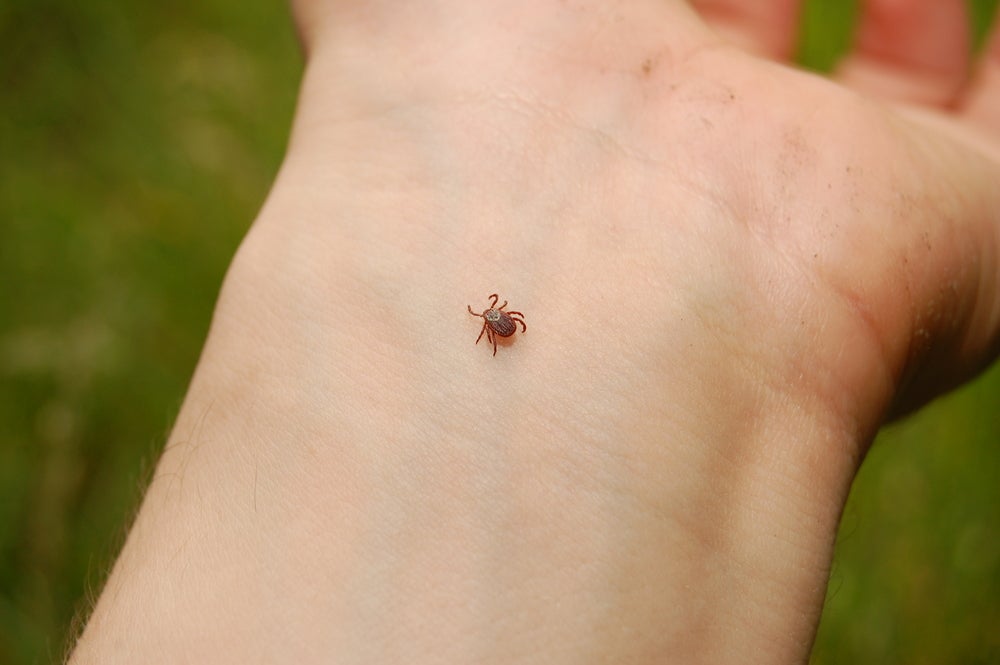Ticks can be found all over the U.S., and the list of tick-borne illnesses is getting longer. Seven new tick illnesses were discovered between 2004 and 2016, and they can be deadly.
Tick prevention is tricky, because these tiny arachnids can easily be missed—but just because you can’t see them doesn’t meant they aren’t there. If you’re like us at The Dyrt and live for the outdoors, regular tick checks and prevention strategies are part of the deal for any camping trip.
Tick Prevention Tips for Campers

Unless you avoid the outdoors completely, you can’t avoid ticks. They cling to clothes, bags, shoes, and gear, and travel with you even when you’ve left their habitat. Although ticks are generally more active in warmer temperatures, the risk of a tick bite is year-round. Fortunately, there are things you can do to reduce your risk. Here are some tips for tick prevention—along with what to do if you’ve been bitten.
Use Tick Repellent
There are two main types of tick repellent: essential oils or a chemical repellent such as DEET.
- If you prefer to go natural: This DIY spray is safe for humans and pets, as well as clothing and gear. Does it work for tick prevention? Yes, but you will need to reapply more often than you would a chemical repellent. If you don’t have the time or resources to DIY, Nantucket Spider makes a popular option, or try a spray with picaridin. This synthetic compound has been shown to be as effective as DEET and can also be used on gear.
- If you want the hard stuff: Try spraying traditional chemical repellents—like DEET or Permethrin—on your clothing and shoes. The downfall here, of course, is that these repellents contain chemicals harmful to both your body and the environment. Are they effective? Yes. Do they come with risks? Again, yes. But so does contracting a tick-borne illness.
Do a Regular Tick Check
No matter which route you go for spray, you’ll still need to do a daily full-body tick scan when you’re camping. Here’s how:
- Undress. Start by scanning your ankles. Ticks start low and crawl their way up, so a good rule of thumb is to begin a tick check on your feet and ankles.
- Work your way up. From your ankles, check your legs, behind your knees, and all the way up to your head.
- Check your scalp. Ask a friend or family member to help, or if no one else is present, thoroughly check your own.
While you’re scanning your body, throw your clothes in the dryer on high heat for 15 minutes; the heat kills the ticks hiding in your clothes. If you don’t have access to a dryer, thoroughly investigate your clothing—check seams, pockets, and anywhere ticks could hide, on both sides of your clothes.
Protect Your Pets

Tick prevention is for pets too! From tick collars to cookies to topical solutions, there are ways to ensure that your pet does not carry ticks in from outside. You can also use the essential oil spray on your pup, but you’ll need to do a much more thorough tick check when they come inside. Depending on your animal’s coat, it could be very easy to miss a tick. Speak with your veterinarian to discuss what tick prevention solution will work best for your pet, and remember that tick prevention is for both indoor and outdoor pets.
Spray Your Gear
Spraying your tent with DEET isn’t safe—it’ll ruin your tent’s protective shield. Most campers use permethrin, which lasts for six weeks or for six washings. Permethrin is a harmful, toxic pesticide, but studies have shown it is safe to use on gear and clothing. You can also use natural options like essential oil spray and picaridin.
Wear Protective Clothing
Wear long sleeves and pants to shield your skin; while you’re at it, tuck your pants into your socks and your shirt into your pants. Light-colored clothing will give you a better shot at spotting ticks as they work their way up in search of flesh.
You Found a Tick! Here’s What to Do.

Don’t panic! If you pull a tick out incorrectly, the head can stay embedded in your skin, which can lead to infection. The best way to pull out a tick is with fine-tipped tweezers,or a tick puller tool. Grab hold of the tick as close as possible to the skin and pull upward with steady, even pressure. Thoroughly clean the bite area and your hands, using rubbing alcohol once removed. Do not crush the tick with your fingers—the CDC recommends flushing it down the toilet, putting it in a plastic bag, or dousing it with alcohol. It’s a good idea to take a photo of the tick and draw a ring around the bite spot to keep a lookout for any signs of infection.
Additionally, if you’d like to see what diseases this particular tick is carrying, it’s possible to save the tick and have it sent to a lab for testing. Many Lyme-literate doctors are recommending this as a way to keep tabs on what to look for in case of infection.
Signs of Infection After a Tick Bite
The bullseye rash so often associated with Lyme disease is not, in fact, a reliable way to tell if you’ve contracted the disease. It only shows up in around 70% of Lyme disease cases. Depending on the disease that the tick is carrying, disease transmission can occur in as little as two hours after a tick latches. This is why it’s incredibly important to be diligent about tick prevention. If, however, you miss a tick and find one embedded in you, it helps to know the signs of infection.
Signs of tick-borne illnesses vary depending on your immune system, as well as the type of disease the tick was carrying. Here are some signs you may have contracted a tick-borne illness:
- Full-body rash
- Fever
- Nausea
- Full-body aches
- Headaches
- Unexplained neck stiffness
- Joint stiffness or aches and pains
- Weakness, clumsiness, fatigue
- Unexplained anxiety or depression
- Swollen lymph nodes
Getting Tested for Tick-Borne Illnesses
Early detection is critical for treating tick-borne illnesses, and is usually done with a lab test. You can request that your blood work be sent to IGeneX lab for accurate results in identifying Lyme disease and other tick-borne illnesses. Look for a Lyme-literate doctor in your area as they are well-versed in current tick-borne disease treatment. Your doctor may also run a test for co-infections, as it’s common to contract multiple tick-borne illnesses. If you experience signs of infection, don’t hesitate to seek professional medical advice.
Related Campgrounds:
- Two Harbors Campground MN, Two Harbors, MN
Popular Articles:
Articles on The Dyrt Magazine may contain links to affiliate websites. The Dyrt receives an affiliate commission for any purchases made by using such links at no additional cost to you the consumer.



